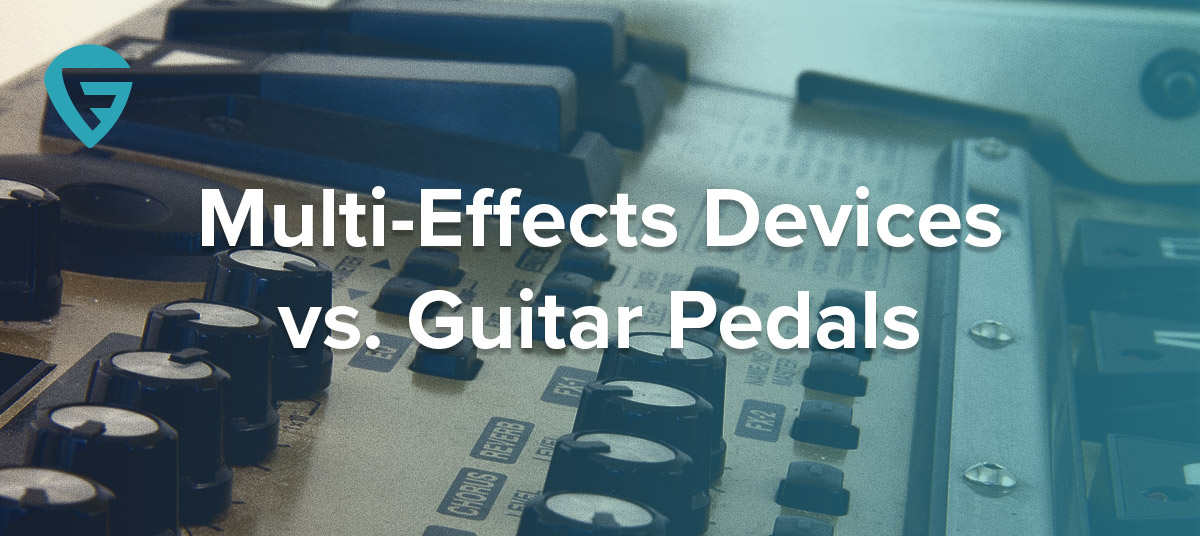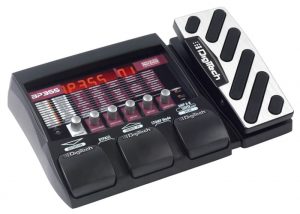- Home
- Instruments
- Gear
- Recording
- Lessons
- Reviews
- Blog

Multi-effects devices vs. pedals, which is best? I love this question. Mostly because there is not one true answer. You have to look at what you need, then look at the advantages and disadvantages. Lucky for you I have put together a list of those advantages and disadvantages below. I have used both kinds of setups so I’m speaking from experience. I even had rack effects at one time controlled with a MIDI pedal (you had to love the 80s).
Pedal Advantages
Pedals are experiencing quite the renaissance lately. I believe this has a lot to do with the flexibility of the new generation of pedals, and the really good switching systems that have been designed to control them. Let’s look at the good and the bad of these little boxes.
Swap-out
If you find a new pedal that does something better than your old pedal it is relatively easy to swap out the old for the new. Depending on how crowded your pedalboard is you might be able to have both pedals. Either way you have the flexibility to make a change that are not global in nature.
Unique
The options are plentiful and the combinations are endless. You will be able to combine things in ways that are outside the norm or beyond the ingenuity of a programmer. Your only limit is your imagination. There are supposed dos and don’ts of pedal order, and you will not be limited by this. No one can tell you not to put your delay in front of your distortion pedal (and no one should).
Builder Strengths
Each builder has something that they are good at, while they struggle in other areas. You won’t be stuck with the limitations of one builder by being able to choose from each builder’s strengths. You may prefer TC Electronics delays and the chorus by JHS, you have the freedom to put both pedals in your chain.
Complex or Simple Simon
You can make your board a complicated mix of digital interfaces, MIDI, and expression pedals, or you can have just a few simple pedals. You know your comfort zone when it comes to technology so build your board to your liking.
Resell Value
Pedals retain their value much better than multi-effect units. I have an old Ibanez Tubescreamer that I could sell for what a new multi-effect sells for. Any of the old multi-effects that I sold never got more than a fraction of what they were worth. I’m not saying every pedal is a gold mine, but you have a better chance of mitigating your losses with pedals.
Pedal Disadvantages
Christmas Tree Light Effect
One thing goes wrong and you’ll have to go through each pedal and patch chord to find the offender. I had a patch cable come out of my wah-wah just before a solo that took me so long to figure out that the band actually stopped playing (the only time that ever happened). I figured it out and ended up using a cable tie to keep that patch cable in place, because it did it again at another gig.
The Hidden Costs
Pedals require power, patch cables, possibly a pedalboard, and a way to attach those pedals to the board. These are costs that can pile up, and next thing you know you’ve sunk more money into your pedalboard than you did into your last guitar. Most pedals are about $100 to $150, but the really nice ones can cost two, three, or four times that amount. You know you want the really expensive ones on your board, because I know I do. You can also find yourself buying more pedals even though it doesn’t fit on your board, because it only costs $100. Do that a three or four times, and you can do the math.
Limited Space
You can fit a lot of pedals on a board, but at some point you will run out of room. You will have to decide which pedals you use the most, and which pedals are only gimmick sounds that you rarely use. You have to decide how to get the most bang for your buck. I lean towards pedals that do more than one thing. They take up less space than two or more individual pedals. The problem that now you are locked into having those two pedals in same location of your effects chain.
Pedalboard Assembly
Putting together a pedalboard with all the patch cables, power cables, worrying about pedal location, and using the space wisely is complicated. If you add in expression pedals and MIDI it gets even harder. Give yourself time to do all this work. Right before a gig is not the time to be doing this sort of setup. Give yourself an afternoon to take your time to set everything up right. You may find that putting two pedals right next to each other doesn’t give you enough room to hit the footswitch without hitting both.
Tap Dancing
For me personally this is the main reason that I switched to multi-effect devices at one point. I wanted to be able to go from a crystal clean sound with a wash of reverb and a touch of chorus to a screaming heavy sound without any other effects with just a touch of a button. There are switching systems that can make this happen, but they take up pedalboard space. I have gone back to individual pedals, and have figured out ways to keep from tap dancing while getting the dramatic sound changes that I love.
 Multi-effects Advantages
Multi-effects Advantages
Multi-effects have gotten better over the years. I remember some of the early ones that had me walking away from them into rack effects. I came back to them later when it made sense to. I see what makes them good, but they also have their limitations.
One Manual to Control Them, One Manual in Tone Bind Them
As pedals get more complex with digital interfaces, how much better to only have to learn one manual as opposed to two, three, ten, or twenty different manuals. This can be offset if you keep your pedals simple, but have you seen what Strymon and Pigtronix have to offer? How can you not be tempted to put some of those more complex pedals on your board? A multi-effect will have a learning curve, but it won’t be as steep as trying to get all your individual MIDI pedals to talk to each other.
The Buffett
You get to try out all those effects that you didn’t know much about. You might find you like rotary speaker effects or that being able to add modulation to your delays is really cool. Multi-effects give you the opportunity to try all these different things. You don’t have to settle for just one type of tremolo, delay, or reverb. Try everything and see what works for you.
Simple Setup
If all you have is a multi-effect device all you need is two cables and a wall wart. They sometimes even come with a gig bag for ease of transport. If your rig becomes more complicated that is your fault not the manufacturer. The easier it is to set up your rig the happier you will be. Less time setting up your gear means more time playing or hanging out, while you wait for the drummer to get set up.
Presets
If you are new and are only just learning what sounds good most multi-effects come with very usable presets. They also come with some sounds that come out of left-field. It might take a bit, but you’ll learn which are usable and which are better to be overwritten. Then again you might find a way to use that crazy sound that would be cool and not obnoxious.
Multi-effects Disadvantages
Single Point Failure
If a single pedal dies, then you pull it out of the chain and you work around not having it. Your multi-effects unit fails, and unless you have a spare you are out of luck for that practice or gig. Both situations can be frustrating, but one is more devastating than the other. A well-made pedal is more fixable than a cheaply made multi-effect (believe me I know).
On the Fly Editing
It is hard to change a setting mid-show on a multi-effect. If your distortion is too harsh for the room it might be several steps to change that as opposed to turning a knob on a pedal. If you use multiple patches changing them all while playing a gig is nearly impossible. There are some pedals that are getting as complicated as multi-effects, but not all of them are.
Tone Compromise
Multi-effects are a jack-of-all-trades and a master of none. Some day they might match pedals tone for tone, but that day is not today. This can be a bigger deal to you as a player than it is to the audience. The acoustics of most rooms will not allow someone to discern an EHX Memoryman from a digital replica. If this is going to drive you crazy as a player, than you better be aware of this before you start shelling out your hard earned cash.
Even the Kitchen Sink
It is so easy to go overkill when you have such a plethora of sounds just a footswitch away. You might have to make compromises with individual pedals, but a multi-effect has everything plus a little more. You can definitely go overboard very quickly with all those options.
Quality
There are some good pieces of gear out there, but let’s be honest many of the multi-effect devices are designed for the beginner. There are plenty of bells and whistles to excite the novice, but there isn’t the build quality. They have cheap switches and plastic casings that are just waiting to fail you.
The Final Word
In the beginning or in the right situation a multi-effect device is a very good choice. It can be a great learning tool for what you like and what you don’t like. It can teach you how to put together a tone that really inspires you. It is easy to transport, and setup is a breeze. If you do not have to deal with the rigors of the road or being in a gigging band, then it is a great option. Pedals are not perfect, but they shine in the sound quality and uniqueness departments. In the mind of many guitarists these are the most important factors. Despite the troubles they may bring they are definitely little boxes of wonder.
So go out there and give each a try, and see which one works best for you. Let me know which multi-effect or pedal is your favorite. Right now I’m in love with my Strymon Lex, and I keep finding reasons to turn it on no matter what the song is.

Matthew Gonzalez says
Many pros use the axe fx II
vlad says
awesome post. I recently switched to pedals at home and was in doubt if this is the way for me., This post helped me to clarify what I want and why 🙂
Kutalia says
Some of the Boss Multi-FX processors (from ME series, for example) are built like tanks. And not sure if digital reverb/delay pedals sound significantly better than modern processors. It might be ideal to plug a simple Multi-FX pedal just for effects/noise-reduction into a FX loop, then put your favorite stompboxes in front or use amp’s distortion. Anyways, the fact is pedal sales are dropping. I.E. either players are getting tonedeaf or digital products are getting better.